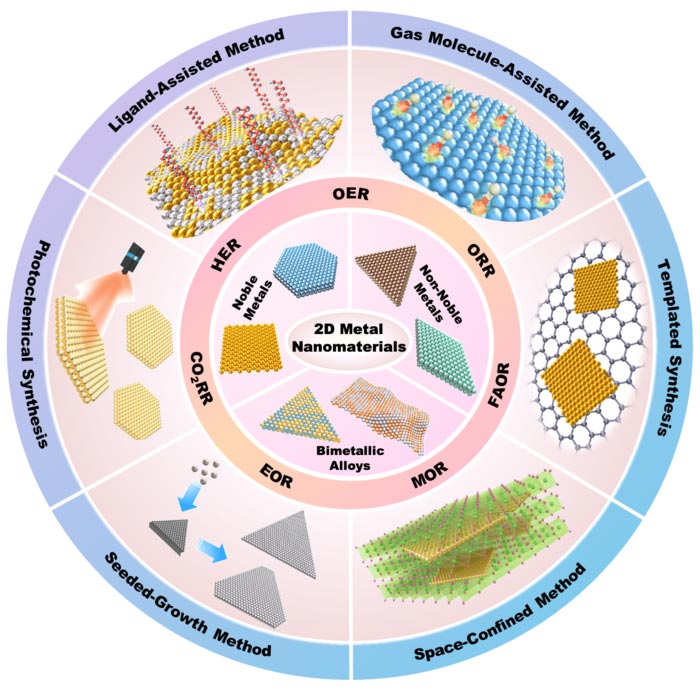Wet-chemical synthesis of two-dimensional metal electrocatalysts

The center shows different types of 2D metal nanomaterials, including 2D noble metals, 2D non-noble metals and 2D bimetallic alloys. Arround the center, it shows seven typical electrocatalytic reactions, including HER, OER, ORR, FAOR, MOR, EOR and CO2RR. Outside, there are six typical wet-chemical synthetic methods for the preparation of 2D metal nanomaterials, such as ligand-assisted synthesis, gas molecule-assisted synthesis, templated synthesis, space-confined synthesis, seeded-growth synthesis and photochemical synthesis.
Credit: ©Science China Press
With the increasingly serious global energy crisis caused by the excessive consumption of fossil fuels, developing clean, efficient, and sustainable energy conversion technologies is highly desirable. Electrocatalysis is one of the most promising methods to produce clean energy. However, the wide commercial applications of electrocatalysis have been severely hindered by the sluggish kinetics in electrochemical reactions, as well as the high cost and low stability of electrocatalysts.
Therefore, rational design and preparation of the highly efficient and stable electrocatalysts have become one of the most popular research directions. To date, 2D metal nanomaterials have been extensively studied in electrocatalysis due to their high surface-to-volume ratio, abundant active sites, high conductivity and superior intrinsic catalytic activities.
As known, it is quite difficult to synthesize 2D metal nanomaterials, since 2D metallic nanostructures possess fairly large surface energy of a specific facet, which is thermodynamically unfavorable. While capping agents used in wet-chemical synthesis can greatly reduce the surface energy of nanomaterials and thus facilitate the growth along the specific crystalline orientation of metal nanocrystals. Therefore, wet-chemical synthesis using various kinds of capping agents has become the most powerful strategy to controlled synthesis of 2D metal nanomaterials with different morphology, thickness, size and crystal phase in large scale.
In a new review acticle published in the Beijing-based National Science Review, scientists at City University of Hong Kong and Nanyang Technological University gave a brief overview and personal perspectives on the recent research advances in the wet-chemical synthesis of 2D metal nanomaterials for electrocatalytic reactions.
The controlled synthesis of 2D metal nanomaterials with desired composition, size, thickness and crystal phase is essential to explore their physicochemical properties and various applications. The authors first introduced the typical wet-chemical synthetic methods for the preparation of 2D metal nanomaterials (e.g., noble metals, non-noble metals, and bimetallic alloys), such as ligand-assisted synthesis, gas molecule-assisted synthesis, templated synthesis, space-confined synthesis, seeded-growth synthesis, etc. Since 2D metal nanomaterials have aroused tremendous research interests owing to their structural merits, such as high surface-to-volume ratio, abundantly exposed surface active sites and unique electronic property, they summarized the recent progress in the usage of 2D metal nanomaterials as electrocatalysts in various electrochemical reactions, including hydrogen evolution reaction (HER), oxygen reduction reaction (ORR), oxygen evolution reaction (OER), ethanol oxidation reaction (EOR), methanol oxidation reaction (MOR), formic acid oxidation reaction (FAOR), and carbon dioxide reduction reaction (CO2RR).
Although tremendous efforts have been devoted to the preparation of 2D metal electrocatalysts, many challenges still remain. Based on the current research progress, the authors proposed some challenges and potential research directions, including 1) investigating the formation mechanisms of 2D metal nanomaterials using in situ characterizations; 2) enriching the library of 2D metal nanomaterials; 3) finely tailoring the structures of 2D metal nanomaterials.
See the article:
Wet-Chemical Synthesis of Two-Dimensional Metal Nanomaterials for Electrocatalysis
https://doi.org/10.1093/nsr/nwab142
Journal: National Science Review
DOI: 10.1093/nsr/nwab142
All latest news from the category: Life Sciences and Chemistry
Articles and reports from the Life Sciences and chemistry area deal with applied and basic research into modern biology, chemistry and human medicine.
Valuable information can be found on a range of life sciences fields including bacteriology, biochemistry, bionics, bioinformatics, biophysics, biotechnology, genetics, geobotany, human biology, marine biology, microbiology, molecular biology, cellular biology, zoology, bioinorganic chemistry, microchemistry and environmental chemistry.
Newest articles

Innovative 3D printed scaffolds offer new hope for bone healing
Researchers at the Institute for Bioengineering of Catalonia have developed novel 3D printed PLA-CaP scaffolds that promote blood vessel formation, ensuring better healing and regeneration of bone tissue. Bone is…

The surprising role of gut infection in Alzheimer’s disease
ASU- and Banner Alzheimer’s Institute-led study implicates link between a common virus and the disease, which travels from the gut to the brain and may be a target for antiviral…

Molecular gardening: New enzymes discovered for protein modification pruning
How deubiquitinases USP53 and USP54 cleave long polyubiquitin chains and how the former is linked to liver disease in children. Deubiquitinases (DUBs) are enzymes used by cells to trim protein…



